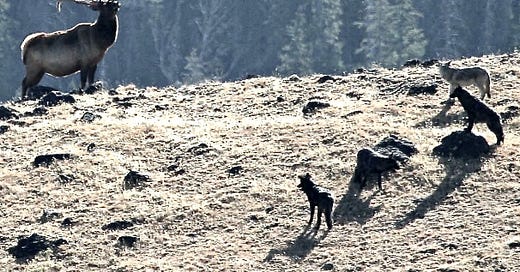An often repeated criticism by the anti-wolf crowd is that wolves are ruthless killing machines compelled by instinct to take whatever prey crosses their path. To check the reality of that statement, I tracked down the writings of some well-respected wolf experts.
It turns out that wolves are far from being ruthless killers. In reality, because of a number of factors, they struggle to bring down prey. Yellowstone wolves, for example, only succeed 21% of the time when hunting, according to David Mech and Rolf Peterson, renowned wolf biologists writing in the book Wolves Behavior, Ecology, and Conservation. “In no case,” they add, “can a wolf merely walk up and kill a healthy ungulate that is more than a few days old.”
And bringing down a meal can be deadly for the hunter as well as the hunted since wolves are not well equipped for the job. So instead of killing indiscriminately, wolves must choose “weaker and naive animals and have their greatest success” with elk calves and older elk, writes Jim Halfpenny, an eminent naturalist and author of Yellowstone Wolves in the Wild.
In fact, the average female elk killed by Yellowstone wolves is about fourteen years old, writes Halfpenny. By that age her teeth are worn down and less efficient for grazing and browsing. This means that she is not getting proper nourishment and is weaker and more vulnerable to attack.
So how do wolves find such a vulnerable animal that may be safer and easier to target as a meal? “Wolves stalk just like a house cat does,” writes Halfpenny. Wolves want to get as close as possible to an elk herd before starting a chase. Once the chase begins, the risk-averse wolves sort and sift the herd trying to find an animal less likely to harm them and more likely to succumb. By sorting and sifting, they might find an animal that is diseased, injured, or born with an abnormality. Or they may detect a male—a potential big meal—that has been weakened by defending his females during the rut. Or they may separate a calf from the protection of the herd.
But wolves also attack healthy animals, even big male elk with dangerous hooves and antlers. Wolves have a strategy that can turn a healthy elk into a vulnerable one: They attack the elk and before the animal can drive them off, they bite it as many times as possible. Those wounds cause blood loss. “Wounded animals,” writes Halfpenny, “seldom travel far, and wounded animals stiffen up, especially during long cold nights. A previously unbeatable foe may now be an easy target.”
But whether their prey is healthy or vulnerable, a wolf’s skeleton is not designed for killing, write wolf experts Dan MacNulty, Dan Stahler, and Doug Smith in a Yellowstone Science article. The problems are many. A wolf’s skull—unlike that of a cougar—is not designed to deliver a killing bite. A wolf’s jaw cannot be locked after biting prey. A wolf’s frontmost teeth are all it has for grabbing prey but those teeth wear with age. A wolf—unlike a cougar and grizzly bear—doesn’t have the right kind of claws and forelimbs for gripping prey. Finally, a wolf’s hunting ability decreases with age; the best hunters are two to three years old. (The average Yellowstone wolf lives to be four or five. Outside the park the average life span is two to three years.)
These shortcomings are significant: a lone wolf only has about a 2% chance of bringing down an adult elk, say MacNulty, Stahler, and Smith. To overcome these shortcomings, wolves band together and hunt in packs. Packs with four wolves, for example, are more successful when hunting elk than packs with fewer wolves.
To take down a bison, a huge meal but dangerous prey, a pack needs around thirteen or more members.
Pack members have different jobs during the hunt. The informative website Living with Wolves describes a hunt this way: “…often fewer than half of wolves on a hunt are actually involved with physically bringing down the prey. The youngest wolves frequently do nothing more than observe and learn from the sidelines. Each of the other pack members contributes according to its particular experience and ability. Speedy, lightly built females often take on herding roles, darting back and forth in front of prey, causing confusion and preventing escape. Slower but more powerful males are able to take down a large animal more aggressively and quickly.”
However they organize it, wolves spend one-third of their time hunting, say Mech, Smith, and MacNulty in their book, Wolves on the Hunt. That’s the most time that wolves spend on any activity. That’s also the time when they risk injury or death.
Wolves know they can die trying to dine, so they wisely seek prey that is less dangerous. But even when they find vulnerable prey, a number of factors including the design of their bodies lead wolves to fail far more often than they succeed.
Wolves are far from being ruthless killing machines.
Thanks for joining me in this Save the Wild.
Please help others learn the facts about wolves by sharing this newsletter.
If you haven’t yet subscribed, I hope you will. It’s free.
Each week you’ll receive a Save the Wild in your inbox. My goal is that you’ll find each newsletter to be a trusted source on threats to wild lands and wildlife, particularly wolves, coyotes, and bison, my favorite Yellowstone neighbors. I’ll provide links that help you learn more and take action.
Log in and leave a comment. I love reading your thoughts and reactions.
I write and photograph to protect wildlife and preserve wild lands.
My bestselling In the Temple of Wolves; its sequel, Deep into Yellowstone; and its prequel, The Wilds of Aging are available signed. My books are also available on Amazon unsigned or as eBook or audiobook.
Photo Credits:
Wolves with elk and wolves with bison by National Park Service






Thanks, Rick, for educating people. My heart is permanently broken over the way our wolves are treated.